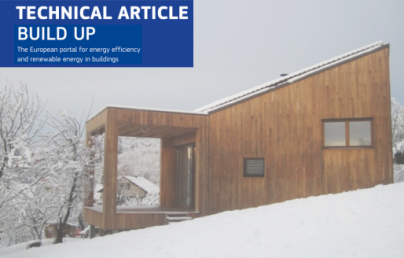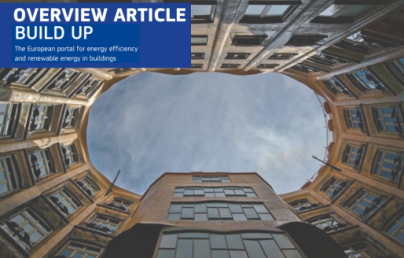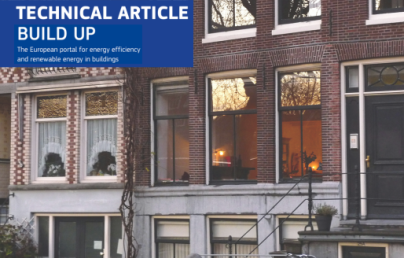Technical Article - Smart textiles for the retrofitting and monitoring of cultural heritage buildings
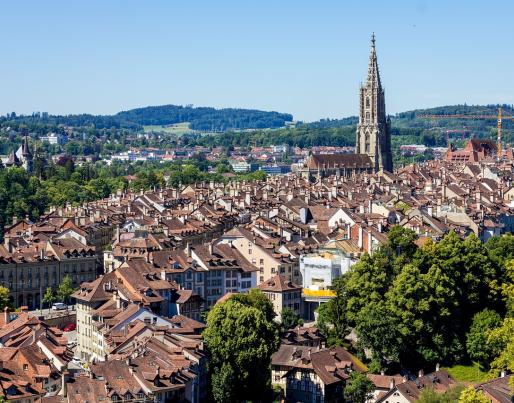
Technical Article - Smart textiles for the retrofitting and monitoring of cultural heritage buildings
Authors:
Michela Rossi (European Commission, Joint Research Centre (JRC), Ispra, Italy)
Dionysios Bournas (European Commission, Joint Research Centre (JRC), Ispra, Italy).
Note: opinions in the articles are of the authors only and do not necessarily reflect the opinion of the EU.
Historic and traditional buildings account for between 10% and 40% of the EU building stock, depending on country and age (Webb 2017). Some are also subjected to legal preservation because of their heritage value. In Italy, for instance, heritage buildings built earlier than 1919 are around 19% of the total, and buildings built between 1919 and 1945 are about 12% (Fabbri et al. 2015).
These buildings, predominately made of stone and brick masonry, generally have poor energy performance and greatly contribute to the impact of the existing global building stock on the environment; buildings in Europe consume 40% of the total energy consumption and generate 36% of total GHG emissions. Replacing the existing buildings with new ones is prohibitively expensive, even implausible for heritage buildings due to their huge cultural, societal and environmental impact. Thus, a systematic renovation of EU buildings (a ‘Renovation wave’) has been seen as a critical point of the European Green Deal (COM(2019)640) to support the EU path towards net-zero carbon targets (COM (2020)662).
Besides the energy inefficiency, historical and heritage masonry buildings often present structural deficiencies and vulnerability (e.g. pre-existing state of damage, environmental degradation, lack of maintenance), leading to collapse and severe damage during recent earthquakes (e.g. Central Italy 2016). This results in significant economic loss, severe injuries and loss of human lives.
Over the last decade, a new concept for addressing both energy and seismic retrofitting within an integrated intervention has demonstrated better cost-effectiveness, safety and efficiency (Marini et al. 2017, Triantafillou et al. 2017, Bournas 2018, Pohoryles et al. 2020). When dealing with historical buildings, this holistic approach must also comply with the impact of the interventions on the heritage value. Thus, retrofit measures (technologies and materials) must be compatible with historical buildings, maintaining the cultural asset's integrity, identity, and functional efficiency while protecting against seismic hazards and improving thermal performance.
Another crucial aspect when dealing with existing structures is monitoring their health condition. Using efficient and accurate Structural Health Monitoring (SHM) systems is emerging as a robust measure to assess structural performance and provide valuable information to plan/assess cost-effective and sustainable maintenance/retrofitting decisions.
Combined seismic and energy retrofitting with textile-based composites and thermal insulation
The novel concept of achieving combined seismic and energy retrofitting in a building envelope is illustrated in Figure 1. This solution combines high-strength lightweight textile reinforcement (i.e. carbon, glass, basalt or natural bidirectional fibres) for seismic retrofitting, whereas an additional insulation material or a heating system is combined with reinforcement for achieving energy retrofitting. Bonding of the reinforcement to the building envelope is realised using an inorganic binder such as cement-based or cement-free mortars (e.g. lime-based or geopolymers). The inorganic matrix results essentially in a TRM composite which also provides the required fire resistance when the selected thermal insulation has moderate fire resistance.
Bournas (2018) proposed the combination of TRM with varying, conventional or advanced, thermal insulation materials (e.g. TRM + Polyurethane, TRM + Extruded polystyrene, TRM + Aerogels) or the integration of capillary tube heating systems within the TRM (see Figure 1). Several studies (Gkournelos et al. 2020, Karlos et al. 2020, Gkournelos et al. 2022) have recently investigated the structural performance of TRM + polystyrene/polyurethane boards for retrofitting masonry structures. Very recently, researchers investigated the energy (Bae et al. 2022) and seismic (Baek et al. 2022) performance of textile and capillary tube composite panels (TCPs) for retrofitting the envelope of reinforced concrete and masonry buildings.

Figure 1. Different applications of TRM with thermal insulation panels proposed by Bournas 2018
However, all these studies did not systematically explore the possibility of adopting these hybrid systems to masonry buildings with historical characteristics. Indeed, depending on the buildings' architecture and heritage values, adding thermal insulation panels on the external façades is not always allowed because such an intervention alters their architectural and geometrical features. When indoor surfaces do not present that architectural value, internal thermal insulation becomes a promising strategy for improving thermal performance. Nevertheless, its application must be carefully evaluated to avoid possible pathologies caused by moisture problems. Moreover, the TRM composite has to be designed using a binder which has to be compatible with the physical and mechanical properties of historic masonry.
In addition, at present existing strengthening techniques do not provide SHM features, which appear to be a crucial aspect for existing deteriorated structures (Del Grosso 2013), especially for heritage buildings (Glisic et al. 2007), where data on their structural state is completely missing. A further step forward in developing a smart multifunctional retrofitting system can be an integrated structural health monitoring solution to assess the actual mechanical and environmental state of the historical building.
Objectives and research methodology
In this context, the STRETCH project intends to investigate experimentally and numerically a hybrid system based on TRM combined with thermal insulation systems, coupled with fibre optic sensors embedded in the TRM composite for achieving real-time monitoring and control of both the mechanical and environmental (e.g. strain and internal/external temperature) state of the retrofitted historic masonry building.
Figure 2 illustrates a schematic view of the hybrid system, which includes:
A TRM composite designed to be compatible with historic masonry structures' physical and mechanical compatibility. Moreover, both basalt and natural fibre textiles are investigated since they both represent attractive alternatives as reinforcing materials due to their good mechanical properties and the possibility of meeting sustainability requirements,
A thermal insulation system, conventional (thermal plaster) or innovative (e.g. capillary tubes embedded in the mortar),
Fibre optic sensors embedded in the composite which allow for evaluating structural damage but also a tool for detecting thermal variations in CH building envelopes.
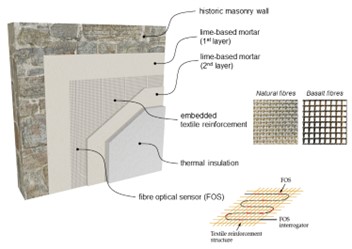
Figure 2. Schematic view of the novel hybrid structural-energy system integrated with FOS for monitoring.
The specific objectives of the STRETCH project are the following:
To design and develop a new hybrid system that provides combined structural and energy retrofit plus SHM for existing masonry buildings using smart multifunctional textiles, and assess this system experimentally.
To develop and calibrate a novel macro-element model for conducting parametric nonlinear numerical analyses for the structural assessment of typical historic masonry buildings strengthened with the proposed system.
To perform parametric dynamic energy simulations to investigate the energy performance of different thermal insulation systems.
Experimental structural assessment of the novel system
An extensive experimental operation has been planned to explore the mechanical behaviour and monitoring features of the novel retrofitting system applied to two-leaf masonry stone with poor lime-based mortar, which is one of the most common masonry typologies and morphology found in historic buildings (Fig. 3a).
Regarding the TRM composite design, a breathable structural geopolymer mortar made from pure natural lime and geo‑binder and cement-free is used to comply with historic masonry structures' physical and mechanical compatibility. Moreover, besides adopting conventional basalt textiles, flax fabrics are also investigated since they both represent attractive alternatives as reinforcing materials due to their good mechanical properties and the possibility of meeting sustainability requirements. The application of TRM compatible with stone masonry is illustrated in Fig. 3b. Regarding energy upgrading, two different techniques are used - thermal insulation EPS boards and thermal plaster.
The textile reinforcement is also equipped with distributed optical fibre sensors (Figure 3c) to measure strain evolution in the TRM composite during the tests. These sensors can register deformations associated with thermomechanical and structural effects, whereas future development towards smart buildings could associate the FOS temperature measures with the thermal comfort of historic buildings.

Figure 3.(a) Some masonry wall specimens for the structural tests, (b) application of the TRM reinforcement on the masonry support, and (c) anchoring the optical fibre to the textile before embedding in the mortar.
Energy assessment and cost-benefit analyses
Dynamic energy simulation analyses on a real case study are in progress. The analyses assess multiple energy retrofit scenarios, including the hybrid system proposed in the STRETCH project. A cost-benefit assessment will also be performed to evaluate the economic advantage of the proposed solution besides the energy and structural improvements.
The STRETCH Project strives to conduct advanced systematic research towards developing a hybrid structural-plus-energy retrofitting and monitoring solution that combines inorganic textile-based composites compatible with historical masonry buildings, integrated with thermal insulation systems and distributed fibre optic sensors.
Such an innovative realisation of all retrofitting and monitoring interventions into one allows for achieving both the required safety and energy performance and also provides SHM features while keeping the overall intervention cost low by dramatically reducing the labour cost, as all the interventions are carried out at once. Experimental and numerical investigations are in progress and will be fully exploited at the end of the project.
This work is funded by the European Union's Horizon 2020 research and innovation programme under the Marie Skłodowska-Curie grant agreement No 896300 — 'STRETCH - Smart Textiles for RETrofitting and Monitoring of Cultural Heritage Buildings ' and hosted at the Joint Research Centre of the European Commission.
References
Bae S., Oh J., Kim J., Baek E.R., Nam Y. (2022) Energy performance analysis of textile and capillary tube composite panel system by computational fluid dynamics and real scale experiments. Energy and Buildings, 258:111825.
Baek ER, Pohoryles DA, Kallioras S, Bournas D, Choi H, Kim TH (2022) Innovative seismic and energy retrofitting of wall envelopes using prefabricated textile- reinforced concrete panels with an embedded capillary tube system. Engineering Structures, 265:114453.
Bournas, D. A. (2018) Concurrent Seismic and Energy Retrofitting of RC and Masonry Building Envelopes Using inorganic Textile-Based Composites with Insulation Materials: A New Concept. Elsevier Composites PartB: Engineering, 148, 166-179.
COM(2019) 640 "The European Green Deal - Communication From The Commission To The European Parliament, The European Council, The Council, The European Economic And Social Committee And The Committee Of The Regions", European Commission, Brussels, November 12, 2019.
COM(2020) 662 "Communication from the commission to the european parliament, the council, the european economic and social committee and the committee of the regions - A Renovation Wave for Europe - Greening Our Buildings, Creating Jobs, Improving Lives", European Commission, Brussels, October 14, 2020.
Del Grosso, A. (2013). Structural Health Monitoring: research and practice. Proc. of the 2nd Conf. on Smart Monitoring, Assessment and Rehabilitation of Civil Structures.
Fabbri K. , Zuppiroli M., Ambrogio K. (2012) Heritage buildings and energy performance: mapping with GIS tools, Energy and Buildings, 48 , pp. 137-145, 10.1016/j.enbuild.2012.01.018
Glisic, B., Inaudi, D., Posenato, D., Figini, A., Casanova, N. (2007). Monitoring of heritage structures and historical monuments using long-gage fiber optic interferometric sensors; an overview. The 3rd Int. Conf. on SHM of Intelligent Infrastructure, Vancouver, Canada, November 13-16, 2007.
Gkournelos, P. D., Triantafillou, T. C., & Bournas, D. A. (2020). Integrated Structural and Energy Retrofitting of Masonry Walls: Effect of In-Plane Damage on the Out-of-Plane Response. Journal of Composites for Construction, 24(5), 04020049. https://doi.org/10.1061/(asce)cc.1943-5614.0001066
Gkournelos, P. D., Azdejković, L. D., & Triantafillou, T. C. (2022). Innovative and Eco-friendly Solutions for the Seismic Retrofitting of Natural Stone Masonry Walls with Textile Reinforced Mortar: In- And Out-of-Plane Behavior. Journal of Composites for Construction, 26(1). https://doi.org/10.1061/(ASCE)CC.1943-5614.0001173
Karlos, K., Tsantilis, A., & Triantafillou, T. (2020). Integrated Seismic and Energy Retrofitting System for Masonry Walls Using Textile-Reinforced Mortars Combined with Thermal Insulation: Experimental, Analytical, and Numerical Study. Journal of Composites Science, 4(4), 189. https://doi.org/10.3390/jcs4040189
Marini, A., C. Passoni, A. Belleri, F. Feroldi, M. Preti, G. Metelli, P. Riva, E. Giuriani, and G. Plizzari, 'Combining Seismic Retrofit with Energy Refurbishment for the Sustainable Renovation of RC Buildings: A Proof of Concept', European Journal of Environmental and Civil Engineering, September 3, 2017, pp. 1–21, doi:10.1080/19648189.2017.1363665.
Pohoryles A., Maduta C., Bournas D.A., Kouris L.A. (2020) Energy performance of existing residential buildings in Europe: A novel approach combining energy with seismic retrofitting, Energy and Buildings, 223, https://doi.org/10.1016/j.enbuild.2020.110024.
Triantafillou, T. C., Karlos, K., Kefalou, K., Argyropoulou, E. (2017) An innovative structural and energy retrofitting system for URM walls using TRM combined with thermal insulation: Mechanical and fire behavior. Construction and Building Materials 133, 1-13.
Webb, A.L. (2017) Energy Retrofits in Historic and Traditional Buildings: A Review of Problems and Methods', Renewable and Sustainable Energy Reviews, 77, pp. 748–759, doi:10.1016/j.rser.2017.01.145
